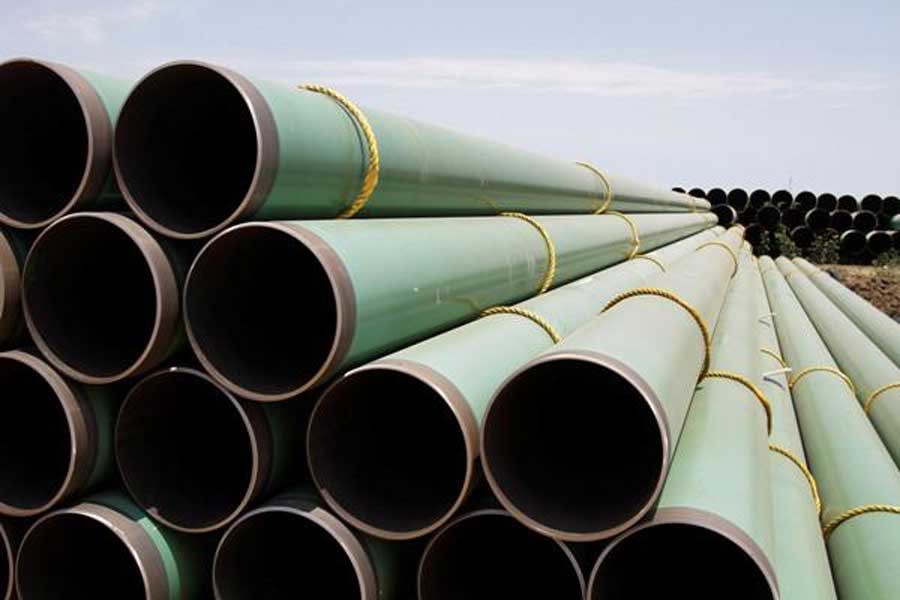The construction of Bangladesh's first dedicated re-gasified LNG-carrying pipeline is already complete and three more are in the process of installation for supplying the fuel, said officials.
A 91-kilometre 30-inch natural gas-transmission pipeline from Maheshkhali to Anwara has already been completed along with necessary testing, managing director of the state-run Gas Transmission Company Ltd (GTCL) Md Atiquzzaman told the FE.
"This pipeline has the maximum capacity to carry around 800 million cubic feet per day (mmcfd) of imported re-gasified LNG (liquefied natural gas)," he said.
A parallel 79-km 42-inch pipeline is currently under construction to carry an additional quantity of imported re-gasified LNG from Maheshkhali to Anwara.
Construction of this pipeline will be completed by 2018.
Maheshkhali, an island in the Bay of Bengal, located in Cox's Bazar district, is up to see a sea change in its pristine position with its transformation into a backyard powerhouse for the country's economy. The government is working to build several LNG-import terminals there.
Officials said construction of another 30-km 40-inch pipeline is under way to carry the imported LNG from Anwara to Fouzdarhat to feed the fuel to users, especially in the port city of Chittagong.
Another 181-km 36-inch Chittagong-Feni-Bakhrabad gas- transmission pipeline would also be laid down soon to supply imported re-gasified LNG across the country through Chittagong.
Petrobangla's wholly-owned-subsidiary GTCL is tasked to lay and look after the country's gas pipelines.
The government contemplates starting LNG import in early 2018 and so there have been concerted efforts underway to move forward building LNG-import infrastructures.
The country's first LNG terminal, a 3.75-million-tonne-per-year FSRU (floating storage, re-gasification unit) being developed by US-based Excelerate Energy, is expected to be commissioned in April 2018.
A second one, also with a capacity of 3.75 million tonnes per annum, is expected in operation by end-2018.
Both the FSRUs will be located on the Maheshkhali Island in the Bay of Bengal, and ownership of the vessels will be transferred to Petrobangla after 15 years of operation.
These LNG-import-terminal projects were both awarded on the basis of unsolicited offers under the Speedy Supply of Power and Energy (Special Provision) Act 2010. The law has a provision of immunity for those involved with the quick-fix remedies.
Petrobangla also plans to set up at least two onshore LNG terminals, each with a capacity of 7.5 million tonnes per year, by 2025.
The state-run petroleum agency on July 13 inked its maiden deal with Qatar's RasGas to import annually 2.5 million tonnes of lean LNG for 15 years.
The price would be linked to the price of international crude oil.
Separately, Petrobangla has signed a MOU (memorandum of understanding) with Switzerland-based AOT Energy on LNG, with an SPA due to be signed by year-end. It also recently floated international tender seeking expressions of interest in spot supply LNG with August 17 as the deadline for closing.
Although Petrobangla's contract with RasGas will be priced against international crude benchmarks, it is counting on government subsidies to enable itself to pay for the imported LNG, said officials.
Earlier this year, the company requested a subsidy of $1.4 billion from the government to foot its LNG-import bill for 2018 -- some 78 per cent of the total estimated cost.
Subsidies will be aimed at bridging the wide gap between international LNG prices and domestic gas prices.
Demand for natural gas, which accounts for more than 70 per cent of the country's energy consumption, is expected to continue growing steadily to close at 7 billion cubic feet (Bcf) per day by 2040, according to Petrobangla, while production is expected to peak above 3.5 Bcf per day by 2023.
[email protected]


